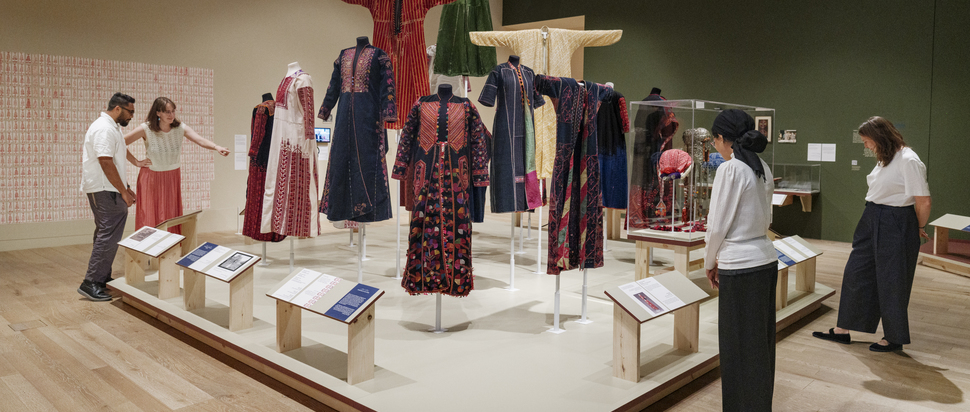Tatreez as a symbol of Palestinian culture
A tale of threads, travel, storytelling and collective histories form a pair of Scottish exhibitions which explore the tatreez – traditional Palestinian embroidery which shares the stories, lineages, hopes and dreams of the Palestinian women who create it
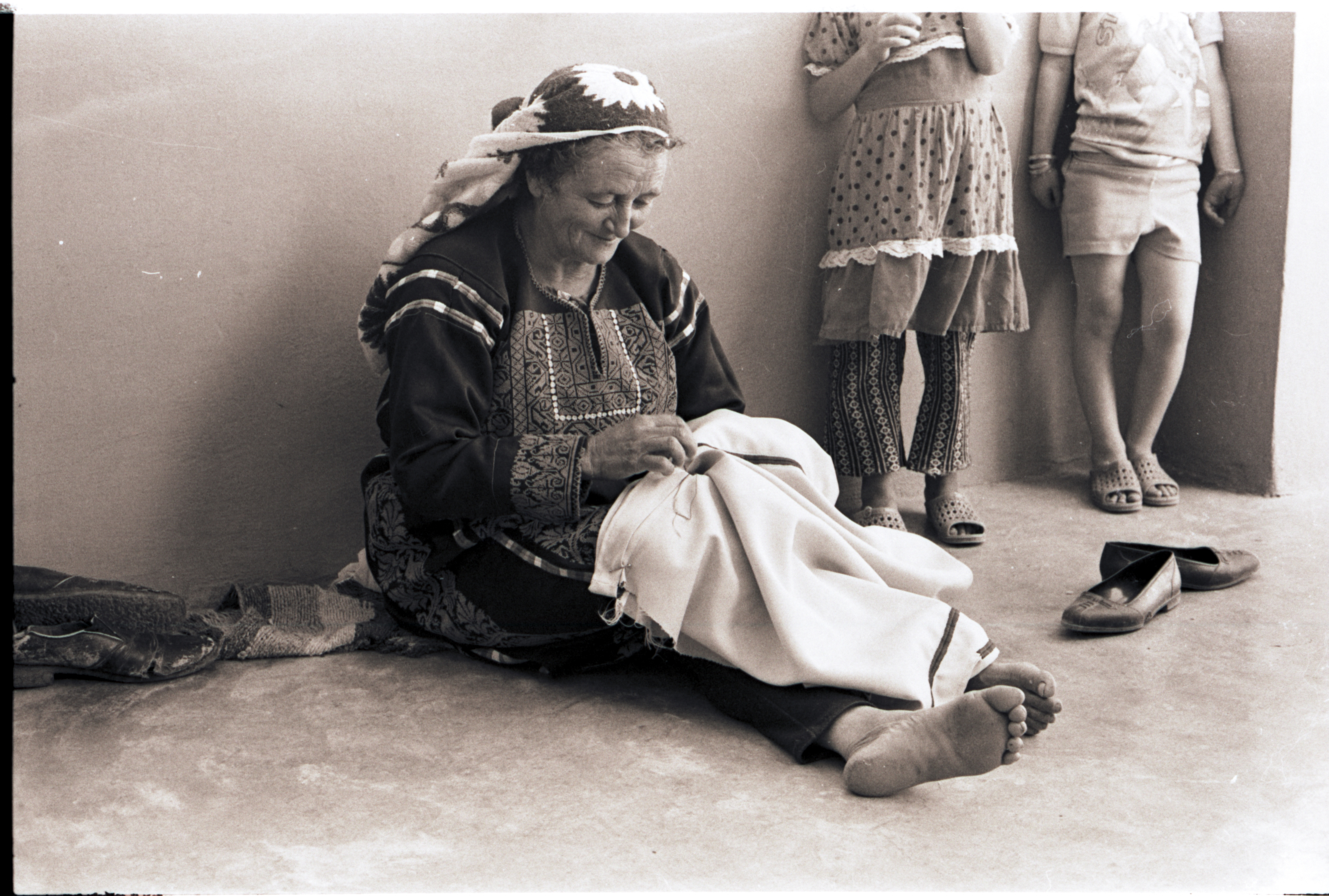
Photo: Fatima Yousef Sewing a Palestinian thobe, in Kobar-Ramallah, in the 1970s, via Palestinian Museum Digital Archive
I first learned about tatreez on 135th Street in Harlem, New York City. It was the first time my lovely friend Dana and I had properly spent time together outside of a protest for Palestinian liberation. The plan was to grab a coffee on what was an exceptionally freezing afternoon in what was shaping up to be quite a snowy January.
We were walking from a pizza shop to the cafe a few blocks over, and Dana mentioned wanting to run a tatreez and tea workshop for our chapter of Students for Justice in Palestine. I had no idea what tatreez was, and in true Palestinian fashion, Dana was wearing a sweater she'd tatreezed a few months earlier. After a minute, I completely understood tatreez's remarkable importance to the Palestinian people.
Tatreez, translated from Arabic as embroidery, is a distinct symbol of Palestinian culture. Fitted with colourful birds of paradise, foliage, agriculture, and other wildlife motifs, tatreez is designed to represent the world that surrounds Palestinian women's villages or nomadic lives. It’s just my luck that within a month of arriving in Edinburgh from New York, the Palestine Museum Scotland opened, and the V&A Dundee launched Thread Memory: Embroidery from Palestine to celebrate the 45th anniversary of Dundee's twin city relationship with the Palestinian city of Nablus.
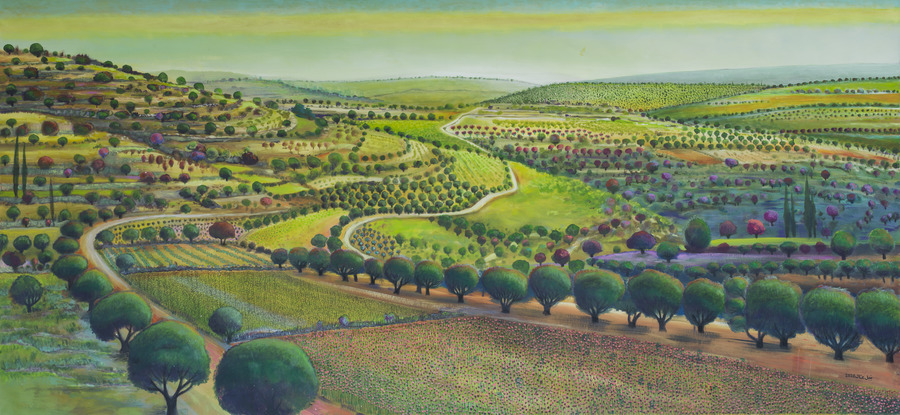
In Pursuit of Utopia by Nabil Anani. Photo courtesy Ziad Anani, Zawyeh Gallery
New Horizons
Dundee is an easy hour-and-a-half trip, and a beautiful drive up the east coast; do be prepared to get sleepy if you take the bus, I missed a few fields of deep purple lavender because nothing makes me fall asleep faster than being in a moving vehicle. Luckily, I woke up and saw a bunch of sheep, which, with a lot of family back in New Zealand, amused me a bunch.
The V&A Dundee building is a picture of the town's past. Resembling a massive ship, it sits in the same place which once saw fleets embark on whaling expeditions. Thread Memory: Embroidery from Palestine is on the second floor, with photographs on the exterior wall welcoming you into a space of Palestinian cultural mourning, joy, and celebration. That’s where I meet Miriam Mallalieu, a Dundee-based curator, and Leena Nammari, a Palestinian artist based in Scotland.
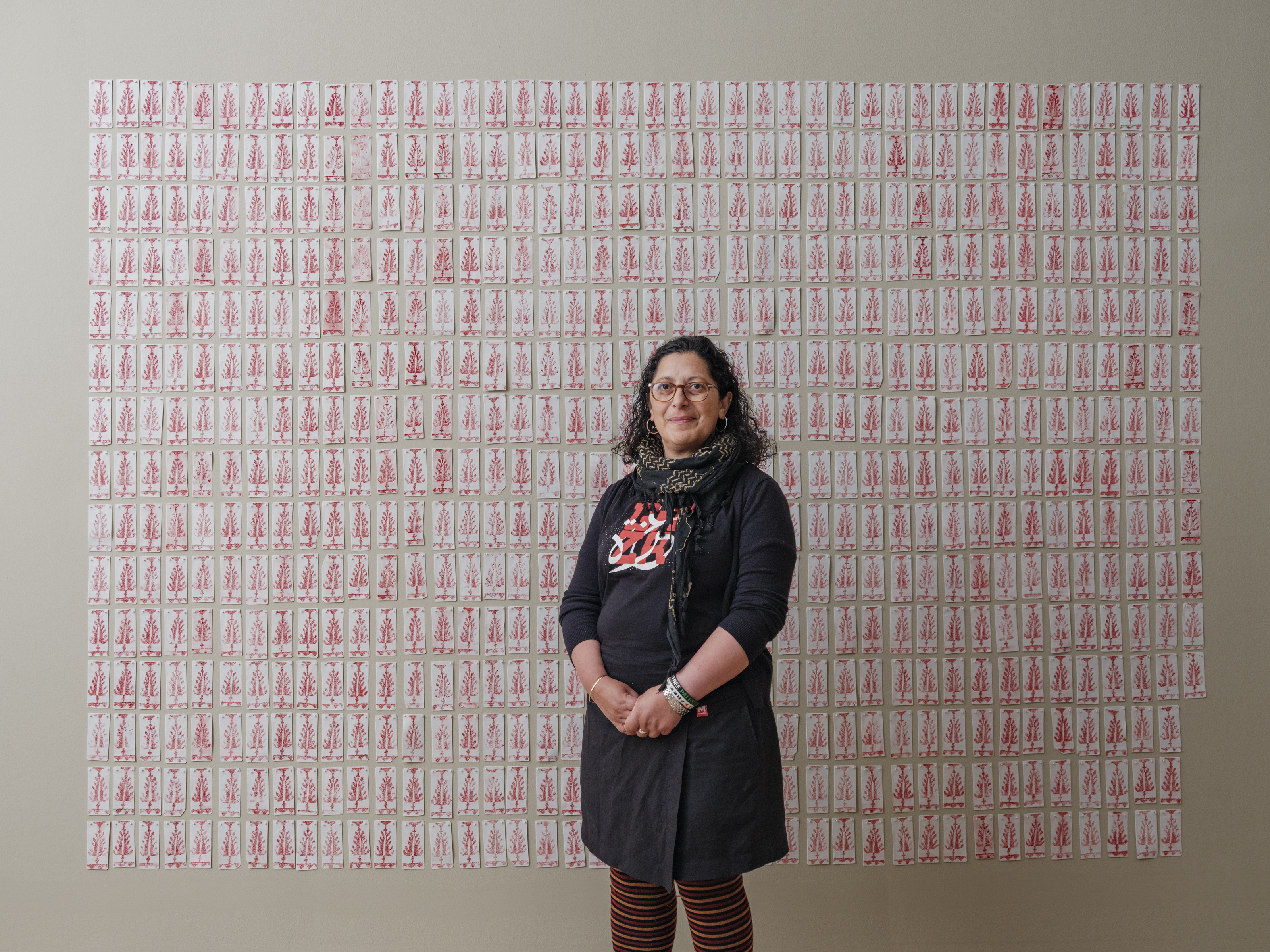
Leena Nammari at the Thread Memory Embroidery exhibition. Photo: Grant Anderson
Identity, diaspora and connection
Nammari was raised in Ramallah, Palestine, and remembers being taught how to stitch tatreez in primary school. For how important tatreez has become to her as an adult, at school, it was only a hassle: "It was part of my art lessons. So we didn't do art, we did tatreez and various other things. I hated doing it in school because, you know, all children hate having anything to do but playing." However much our love for play actually dies when entering adulthood, as Nammari grew up, tatreez became more important to her than a forced creation in primary school art class.
Across Palestine pre-occupation, young girls would learn tatreez from older women in their nomadic communities and villages, similarly to Nammari. As the girls matured, they'd learn to stitch tatreez panels that would be added to a sheet of cloth and sewn into a thobe, a traditional Palestinian women's dress.
The tatreez tradition proceeds today; however, since the occupation of Palestine, the cultural tradition and significance of tatreez changed to reflect the oppression of exile and the reality of being controlled within your homeland. "Because the majority of Palestinians alive today are actually in the diaspora,” Nammari tells me, “very few are living in the places that their tatreez comes from. The one way of actually preserving their identity and who they are is by tatreez." Especially for Palestinian women living in exile, tatreez have remained a point of connection to their families' villages that have been destroyed by the Israeli occupation.
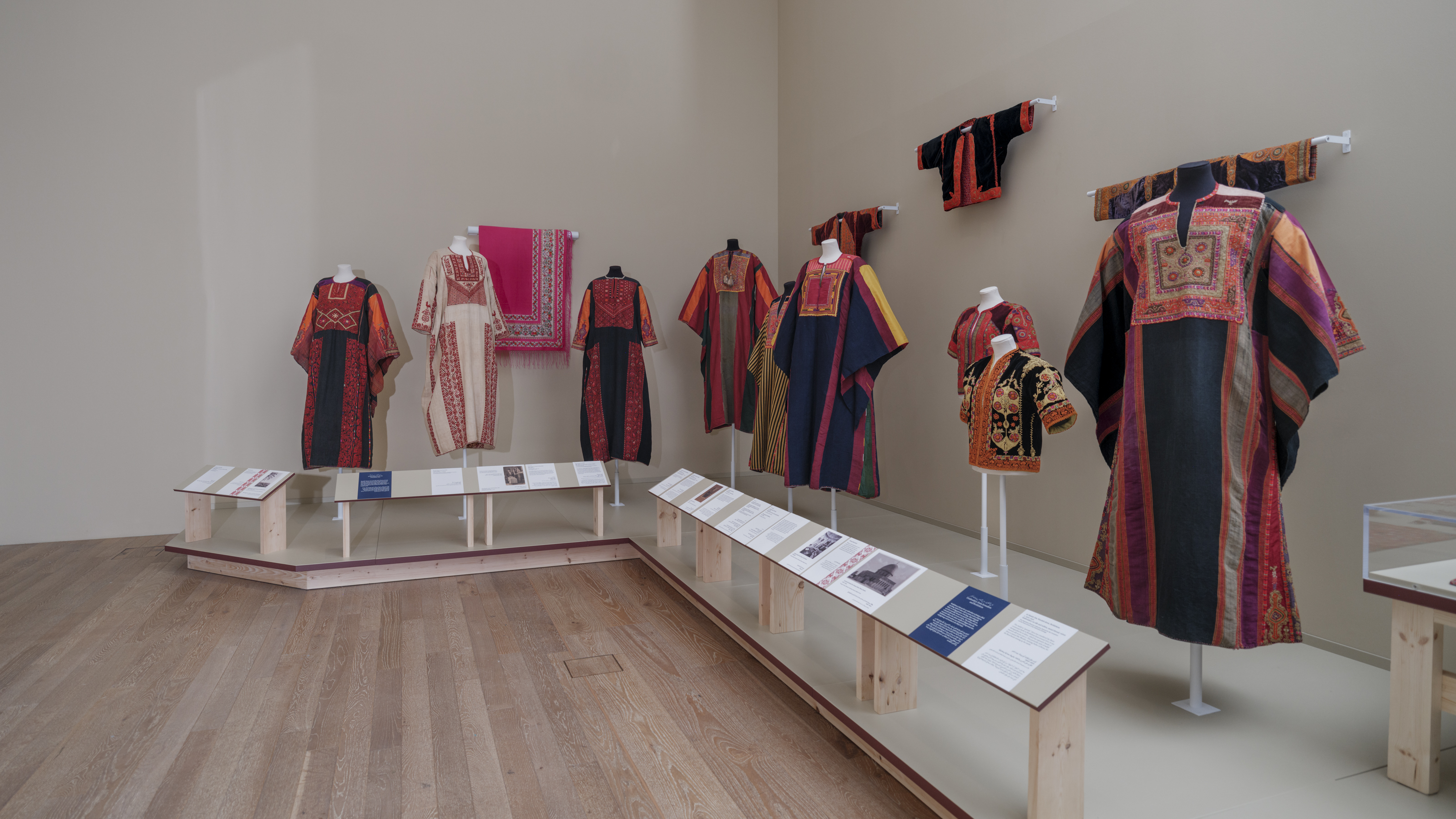
Mourning and celebration: the craft of tatreez
Once the three of us are inside the spectacularly designed room, Mallalieu points to the thobe intended to set the mournful tone of the exhibition. "The exhibition begins with a dress of a woman in mourning to set the mood of a nation's grief." The thobe is dyed with indigo: "This is a dress worn by a woman who is in mourning, shown through the use of blue thread. Often, women would either stitch their dresses with blue thread, or they would dye existing dresses with indigo." The dye naturally washing out of the thobe signified that the women's mourning period was coming to an end.
The thobe even has some coloured tatreez added, which show "a woman's reemergence back into the world following her mourning period." In a sweet, enthusiastic tone, Mallalieu emphasizes: "What this dress shows is how we can read very particular stories of women's lives through the dresses that they wore, which is for me the most exciting part of this exhibition: the clues into histories that aren't often told."
Standing in front of the stunning section of Ramallah, thobes, and veils, the local motifs captured in tatreez come into view. Being in the middle of Palestine, "women would've had time to embroider. So it's a center of craftsmanship." As much as the exhibition focuses on the immense grief felt by the Palestinian people living in exile and under occupation, the Ramallah section manages to capture the joy and celebration experienced by a nation's people. "The red thread is really important throughout all of these dresses, and you'll see that as we go through,” Mallalieu says. “Red is the color of joy and celebration."
Tatreez embraces the phrase "women's work" with intense positivity. "All of this is women's work; look what women can do," Nammari says with a passionate grin. Still, as she points out while we go around the exhibition, the thobes’ signs of wear are a sign of life. "Some are a little bit worn, but they've replaced a patch. 'Cause it can be disassembled, which is very womanly and very practical."
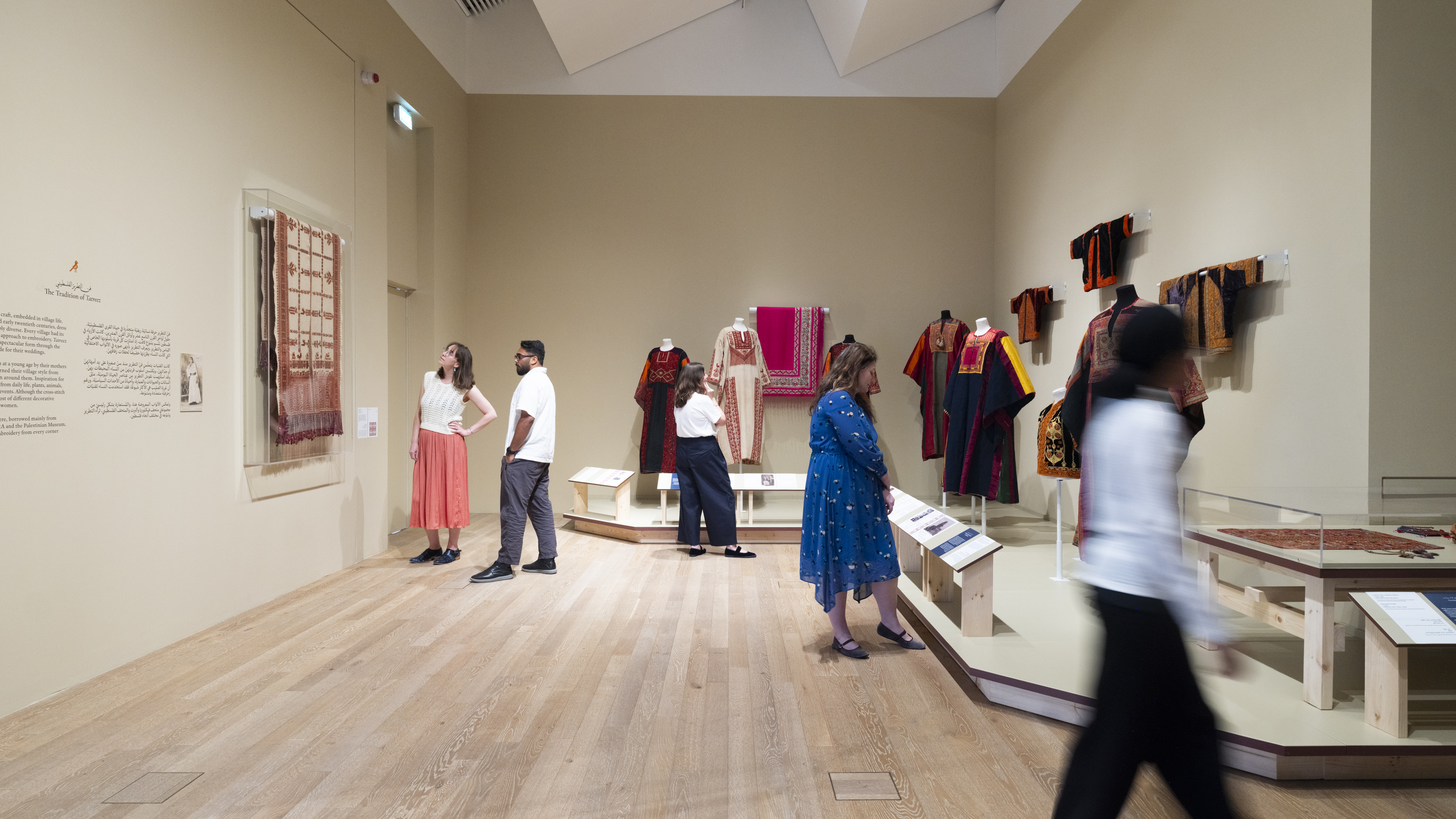
Hanging from the other side of the exterior wall is a veil from Ramallah, dated 1900-1945. "I mean, these stitches are minute; this is cross stitch. They are minute, and going back to the birds, you've got your different cockerel, and that's a phoenix up there. Again cockerels, this pattern here, 'cause this is a Ramallah/Jerusalem area." Nammari believes that this massive veil could have been stitched by a woman or a group. After the women's marriage, she added even more tatreez to the veil.
Israel has led a systematic campaign to erase Palestinian culture and history from the world, and this new exhibition at V&A Dundee (produced in partnership with Art Jameel in Saudi Arabia and the Palestinian Museum in the West Bank town of Birzeit) is a crucial effort to prevent this erasure through the arts. "One of the things that we find is that these items, that at the time women were just making to reflect their lives,” says Mallalieu. “Now they've become these points of history and remembrance for sites that, as we go on, have been erased and have been destroyed," she explains.
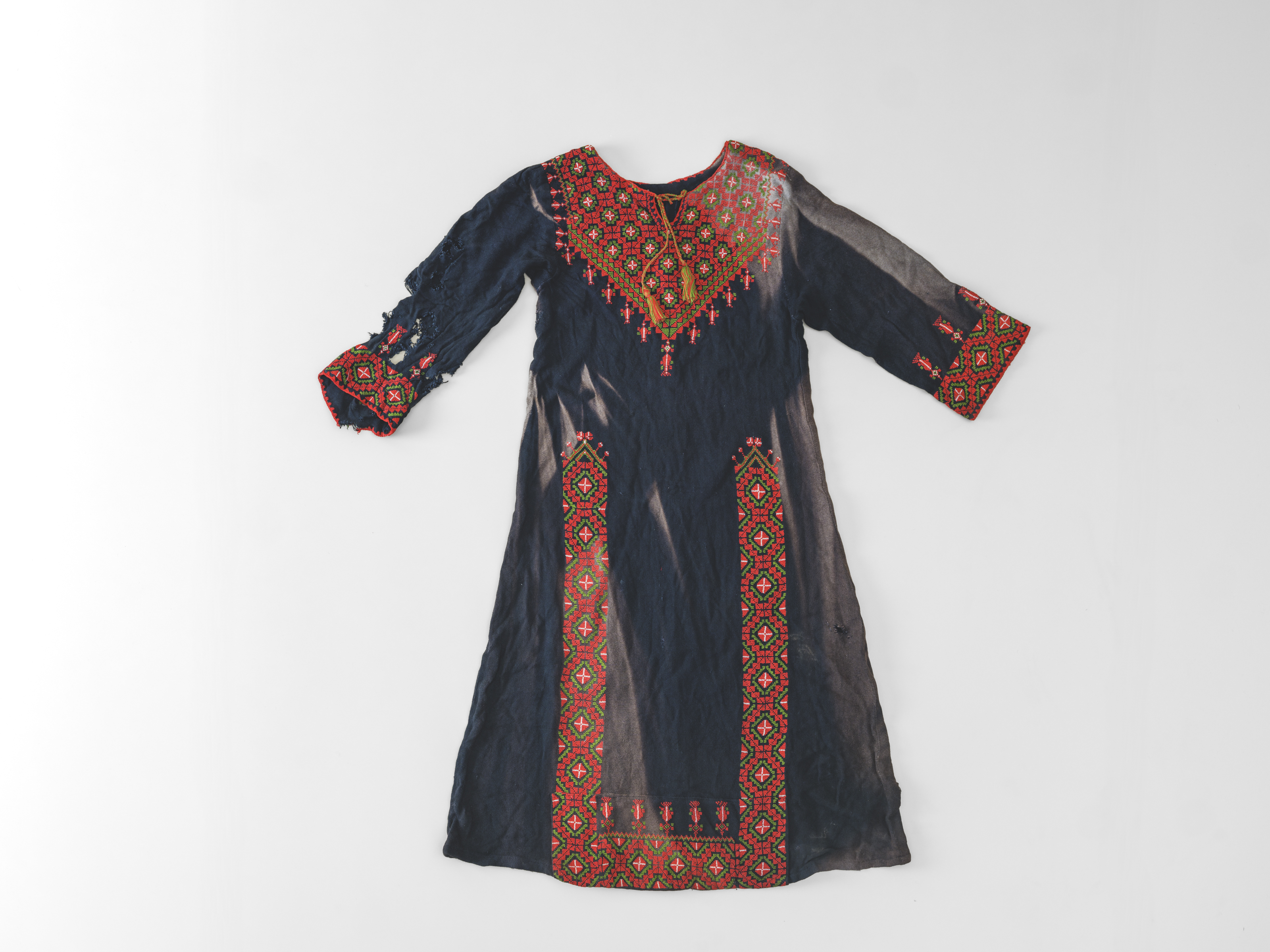
'Proof of existence, assertions of selfhood'
In the last of three rooms that comprise the exhibition, there's a thobe from Gaza on display dated 2000-2010. The accompanying text explains: ‘This thobe, made for a little girl, was damaged in the targeting bombing of the Rafah Museum in Gaza, whose collection was largely destroyed in 2023.’ The explosion was so forceful that the dress flew onto the roof of the building and sat there for eight months.
Israel's genocide in Gaza has continued for over 600 days following the IDF's targeting of the Rafah Museum. "These material artifacts are proof of existence and assertions of selfhood." This point was central to Mallalieu and the broader team’s curation of the exhibition. Thread Memory: Embroidery from Palestine in the face of genocide and occupation is an act of solidarity between art institutions and the Palestinian people.
Back in Edinburgh, in the back room of the Palestine Museum Scotland on Dundas Street, two gorgeous Gazan thobes hang from the ceiling. Maha Sarraf, a Palestinian woman living in Canada, donated these thobes as a collection of six in memory of her late mother.
For a newcomer whose city back home has DIY galleries full of Palestinian art that spring up and never last too long, what a treat it is to have two different spaces to experience such diverse Palestinian art in Scotland. It's special for the Palestine Museum Scotland to be around for the long haul, and for Thread Memory: Embroidery from Palestine to be on at the V&A Dundee until Spring 2026. These arts institutions are a positive sign of permanent Palestinian art exhibitions to come in other international locations.
In that same room at the Palestine Museum, Nammari from my V&A Dundee tour has a piece titled Biblical Jenga. Etched into each block, made of olive wood from Bethlehem, are curses: ‘Biblical in their context, yet innocent in their intent,’ the paper below Nammari's sculpture reads. It's an on-the-nose, 'please do play with me', pissed-off piece of art; a sculpture which makes it seem Nammari never lost her childhood playful spirit after all.
Thread Memory: Embroidery from Palestine, V&A Dundee, until spring 2026, free entry
Palestine Museum Scotland, 13a Dundas St, Edinburgh, open Wed-Sun, 11am-6pm
Subscribe to The Skinny Zap! Every month, as well as the usual weekly events round-ups, we'll be sending out a subscriber-exclusive essay or interview. Expect shenanigans, musings, and the usual best of local arts and culture straight to your inbox.
V&A Dundee exhibition photos by Grant Anderson
